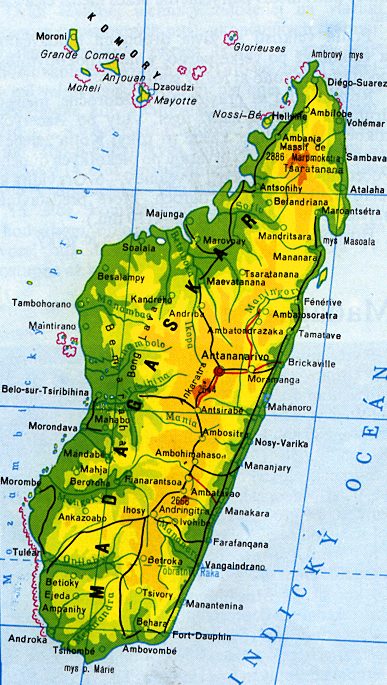
5. Geography
 |
Madagascar is the 4th largest island in the World (after Greenland, New Guinea, Borneo). It has a land mass of 596 000 km2 and a population of 14 million in 1996. It is 1580 km long from north to south, and 570 km from east to west. Madagascar might more accurately be called a small continent. It has a diverse climatic zone, from rain forests in the east, to deserts in the southwest, with mountains and forests in the middle. It is called the “Great Red Island” due to the omnipresent red soil.
Madagascar tore off from the former continent of Gondwana from 120 to 165 million years ago. Today the island is separated from Africa by the 400 km wide Mozambique Channel. The climate is typically tropical. The coastal temperature spread between summer and winter is quite small, but it is more extreme inland. Rainfall in the east is 3200 mm annually, but less than 400 mm inland. The monsoon season lasts from December to April. The highest peak is Maromokotro, rising 2876 meters in the Tsaratanana Massif to the north. The largest rivers are the Mangoky and the Betsiboka. Along the Eastern coast the artificial Pangalanes Channel (600 km long) follows a string of lakes. It is used for ship transport. It is situated in the Indian Ocean and surrounded by coral reefs. Most of the country is within the tropical zone; the Tropic of Capricorn bisects the southern part of the island.
 |
The Capitol is Antananarivo, located in the middle of the country, about 1200 - 1300 meters above sea level. It has more than 1000000 inhabitants. Madagascar has six provinces: Antsiranana (Diégo-Suarez), Mahajanga (Majunga), Toamasina (Tomatave), Antananarivo, Fianarantsoa and Toliary (Tuléar).
Madagascar is one of the poorest countries in the world. The most industrial part of the country is around the city of Antsirabe, a bit south of the capital. Not far from Antananarivo, 20 km to the north, there is former royal city of Ambohimanga. The people of Madagscar were formed from immigrants from Africa, SE Asia and the Arabic countries. There are 18 ethnic groups there, the largest of which are the Merins and Betsils, living around the capital.
Ethnic and linguistic differences have gradually diminished, and since the 19th century, when Madagascar was united, the Malgasy nation was created. This period has also seen a dramatic increase in the population, and almost half the people are younger than 21 years old. Families with many children are common. There are also more than 100,000 foreigners living in Madagascar. Madagascar is paradise for zoologists and botanists. There are a lot of different animals and plants in comparison to Africa. It is characterized by number of endemits, that live only in Madagascar. The rarest plants are in rain forest on Eastern Madagascar, that are the densiest in the world. For example there are more than 1200 species of orchids and in Massif Tsaratanana you can find more bamboo trees as in whole Africa.
The most beautiful rain forest is in National Park Ranomafana. The other curiosity of this island is Baobab tree. Seven of nine species live on here. Local people call it Reniala, that means mother (father) of the forest. You can find this tree on SW part of island sepecially close to town of Morondave. Fauna is different to Africa too. 41 % of birds and more than 90 % of reptiles are endemits. There no original animals with hoop, dogs and cats. The most ineteresting are lemurs (32 species) rare half monkies. This word has latin origin and means bad soul of dead people, that is wandering in forest and running after people. The smallest primates Pygmy Mouse Lemur with weight 35 g belong to them. Some of lemurs accustomed to people and they are a very good attraction for tourists. You can hear their screech in distance more than 2 miles. The well-known reptile is chameleon. Its ability to adjust to surrounding colour is unbelievable.
There are more than 70 species of serpetines there, none is deadly poisoned, more than 200 types of froggs. With coming of people many animals extincted, for example elephant bird, 3 m high with 450 kg and elephant turtle. People from India brought here their habit so called slash and burn. For example in 1960 - 85 more than half of forests was destroyed for creating veldts for zebu imported from India. Madagascar is the most destroyed country in the world and every year 1/4 of island is on fire. Slash and burn activity destroys plants and animals as well. Under control of world organization were established some national parks.
Long time goal is to learn local people to live in harmony with nature. In 1988 World Bank acclaimed 20 year long environmental plan for innovation of natural heritage.